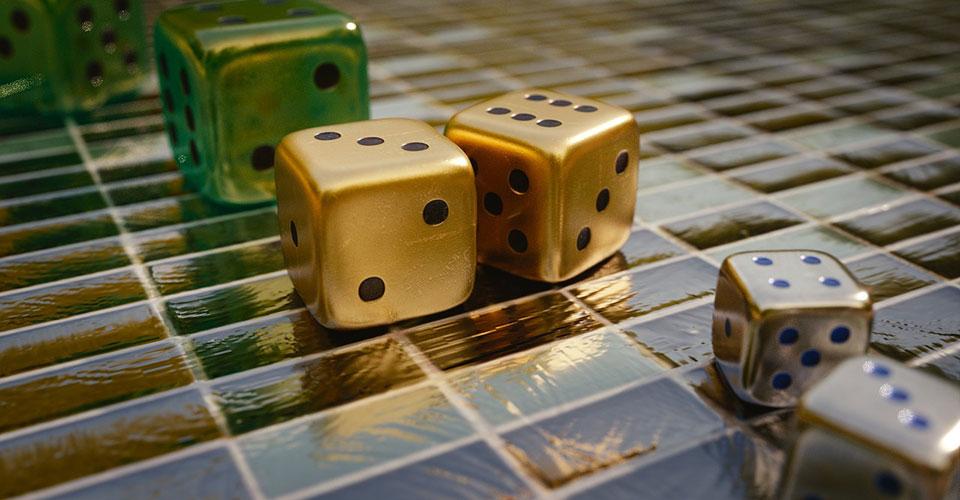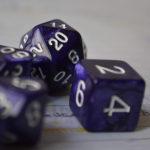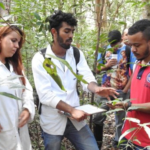
Marko Susimetsä
Collaborative storytelling, familiar from drama pedagogy, has the potential to immerse students into a learning activity. This immersion may be further enhanced with elements adapted from traditional tabletop role-playing games, introducing random chance and surprises into the narrative.
Modern pedagogical thinking has moved away from the classic teacher-centred idea of a classroom where the teacher or textbooks provide new information, students ingest it and then show what they have learned in a test or an assignment at the end of the course. These ideas were mostly based on early cognitive learning theory that studied the human being as an information processor and saw learning as an individual process of knowledge construction (Munyoro, Mukherjee, & Susimetsä, 2019).
In the modern classroom, we see learners as social creatures and learning as a collaborative, social activity where people exchange ideas and construct new knowledge and understanding together (see Gbadegeshin, Appiah, Boateng, & Susimetsä, 2019). This approach is based on Vygotsky’s (1978) sociocultural theory which sees learning as an accumulative and sociohistorical process: instead of individuals, we observe learning communities in schools, at workplaces and hobby groups. Studying a profession is not only about learning the skills and knowledge needed in that field, but also learning to be part of that field’s culture. It is as much about socialisation as it is about skills and knowledge.
The sociocultural theory is one of the theoretical bases for cooperative or collaborative learning methods in classrooms. There exist many types of collaborative learning activities and teaching methods, such as problem-based and phenomenon-based learning. In this article I will look at role-playing games (RPG) and how they can be applied to work as a support and platform for collaborative learning. As a case example, I will describe how I used a role-playing game as a learning activity in professional teacher education for adult students and how it was received by the participants.
This article is based on a pilot experiment that I conducted as part of a project called APOA – Learning Analytics at Häme University of Applied Sciences (HAMK), Professional Teacher Education Unit. The learning analytics aspect of the experiment are reported in a separate article (Susimetsä, in print).
Role-playing games, gamification and education
In teaching based on collaborative tasks, as in any teaching, the greatest challenge is to make learning meaningful and engaging to learners. This challenge has been recognised throughout the ages as can be seen in Comenius’ (1592–1670) statement that it is important to make the teaching “methods palatable, so that everything, no matter how serious, may be placed before them in a familiar and attractive manner” (Comenius, 1896, p. 284) and “amusement and serious study, should be continually joined together” (Comenius, 1896, p. 329).
Drama pedagogy and role-playing in general have been widely used in teaching in all levels of education. Heikkinen (2010, p. 8) describes drama education as a method to allow serious and open play, aiming to actively examine and create culture. More specifically, he discusses how drama pedagogy has been traditionally seen as a method to teach something, as a tool for increasing self-knowledge, or as a tool to learn, for example, collaboration (Heikkinen, 2010, p. 30). Using drama is a way to immerse the learners into the learning experience and the activities can be carried out in a variety of learning environments. Overall, drama education is inclusive and the learning collective.
Traditional drama pedagogy involves a lot of role-play, where learners may take on different roles in, e.g. a customer service situation, therapy session, crisis management or negotiation context. However, the term ‘role-playing game’ introduces another level of consideration: gameplay. Gamification is a trend to implement the engaging elements of games into other contexts, such as education (e.g. Dicheva, Dichev, Agre, & Angelova, 2015). Often these elements introduce scores or points that the participants can accrue, or competitions with winners and losers. Role-playing games differ from this tradition in that they are collaborative, and players must work together in order to achieve their goals.
In a traditional tabletop role-playing game, there is a gamemaster (GM) who designs a story or a narrative and presents it to the players. Each player takes on the role of a character that he/she will design in cooperation with the GM, with different strengths and weaknesses (skills and attributes). Seeing and experiencing the story through the eyes of their characters, as it is narrated by the GM, the players will face problems, puzzles and challenges that they must overcome by working together. In order to check the characters’ success at using their skills, the players are required to roll dice, introducing a degree of chance into the game. As there are no winners, the goal is to create an exciting narrative in co-operation between the GM and the players.
Cheville defines tabletop role-playing games (RPG) succinctly: “The story evolution is determined by the game’s system of rules, a contextualizing plot (module), a game master (GM) who serves as referee and chief story teller, and the players” (Cheville, 2016). RPGs usually consist of long-term plots that involve shorter quests or tasks that are stringed together from one play session to another, allowing the characters to develop their skills and become better able to face even stronger challenges. The GM plays the roles of all the non-player characters in the storyline, interacting with the players, as well as describes all the locations and challenges that the players face. It is important to note that the GM, although he or she has designed the story and its obstacles, is not actively playing against the players.
Cheville (2016) argues that these elements of RPGs can be transferred to curricula in higher education, creating an overarching narrative that allows learners to engage in individual learning tasks and challenges and develop their skills to face even bigger challenges. Such a narrative could be used, for example, to bind together many of the elements of collaborative problem-based learning.
Putting RPGs to work
In my own experiment, conducted as part of the APOA – Learning Analytics project, I chose to work on one of the courses I teach to professional teacher students: Networks in Education. This course is the last one in the professional teacher education programme. It introduces the students to the various kinds of networks and cooperation that professional teachers regularly take part in outside of the department or school environment.
While adapting the course for an RPG implementation, it was necessary to consider the assessment criteria for the course and decide which ones of them were possible to be covered in a narrative. In the 2019 curriculum at Häme University of Applied Sciences (HAMK), the three competence criteria for this course were:
- The teacher student understands the professional role of a teacher as a developer of the workplace and as a contributor to regional development.
- They recognise the opportunities for cooperation offered by different education sector interfaces.
- They know of various national and international vocational education cooperation networks with employers and other partners and their possible uses.
I made the decision to focus the RPG on the second and third criterion and wrote a narrative around the concept of international development project which required a group of Finnish education specialists from various universities and schools to travel to a third world country to export Finnish online educational thinking and practices. The scenario centred around the first week of cooperation and training at the location, including meetings with local project representatives and training sessions with local teacher trainers. In addition to the core topics, the storyline included atmospheric details to further immerse and engage the participants. A limitation to the possibilities and extent of the scenario was posed by the time allowed for a single session: 2.5 hours.
Because of the time limit, I also gave the students a more traditional assignment to familiarise themselves with the course reading and consider their own existing professional and education networks and reflect on their development needs. This covered the aspects of the assessment criteria that I did not believe I could focus on during the RPG implementation.
In order to focus as much attention as possible to the content to be learned, it was important to make sure that the game system was as simple as possible. Traditional RPGs have thick rulebooks full of instructions on how to build characters and how to use various skills and determine their success or failure as well as on the development of the characters over time. In education context, gameplay needs to be simpler: there is not a lot of time to spend on learning game rules, especially if the approach is used only in a single course. Randi and Carvalho (2013) used an RPG to teach an initial course on university level cellular biology and assigned student tutors to run games to smaller groups of students. In order to make the experiment manageable, they devised a simple 3D6 system, where each character had five basic skills with aptitudes ranging from 8 to 16. In order to check whether they succeeded in attempting to use a particular skill, the player rolled three six-sided dice (3D6) and compared the sum to their aptitude in that skill (rolling below the aptitude meant success while rolling above meant failure).
I used the same dice rolling system and built the rest of the game system around it. I determined various types of teacher roles that the participants could build their characters around, such as a researcher, teacher educator, project manager and a special needs teacher. Each of these templates had different base values for five skills and aptitudes (research, problem solving, computer use, charisma, own field) as well as other bonuses to their rolls or networks that they could use to solve the problems that the story put in front of them. The players could then take these templates, adjust the skills and aptitudes, write histories and backgrounds for their characters, and descriptions of the networks that they had built along their career.
In addition, I wrote rules that detailed how each of the five skills were to be used as well as rules for using networks and collaboration on tasks (for example, if more than one character collaborated, they both had to roll their ‘charisma’ to determine if they were able to work together and then roll separate success rolls for the task itself).
The students had a preparatory task of familiarising themselves with study materials on networking and reflecting on their own networks. Then the 12 students participating in the RPG implementation of the course (two students had timing issues and were given separate assignments) were divided into two groups that attended a live Zoom session where the RPG was played through.
The main challenge in planning the story was the focus on networking, which was the topic of the course. RPGs, however, are more holistic in their approach, and in order to create an engaging story on education export it was necessary to also include themes that had been the topics of some earlier courses, such as multiculturality, dialogue, pedagogy etc. Overall, the RPG experience was perhaps more like a final overview of everything that the teacher education programme had taught to the participants over the past year, rather than a learning session for networking only.
Student experiences
After the game session, I sent all the participants an open questionnaire. The goal was to collect information on how the teacher students felt about the RPG teaching method, such as whether it supported or hindered their learning, or if the game mechanics, or the role-playing itself, took too much attention away from learning the content of the course. In addition, they were asked if they might consider using the RPG teaching method in their own teaching in future.
Most of the students felt that the RPG demonstrated networking and supported its learning very well. However, some felt that networks seemed to have a relatively minor role, or that it became more apparent towards the end of the game session.
… playing the RPG supported the learning of the theme, but I felt that networks were not given a big focus, I think more stress was put on the value of cooperation. (Student 1, translated from Finnish)
The game supported the understanding of networks in education field very concretely [. . .] The game brought back palpable memories of my own experiences in education export. (Student 9, translated from Finnish)
The differences in the experiences that the students reported are understandable because the narrative focussed on relatively specific aspect of networking: international project cooperation. While the characters’ existing networks in Finland were part of the character creation and they were a potential resource in gameplay, the players often solved the problems collaboratively and with the resources they had immediately available and did not “contact their friends back home”. In short, networks in education take many forms and a single time-limited narrative cannot encompass them all.
Almost all participants found it easy to step into the role of their character. However, some admitted that it was easy to forget the character when they started discussing the problems that they needed to solve. Also, one respondent commented that the game context was so new that it disrupted the learning to a degree.
It was perhaps more of a challenge, because the game was new [to me]. It was challenging to play the part of the character and not yourself, although the knowledge and skills required were part of my own expertise. (Student 6, translated from Finnish)
I feel that playing a role supported my learning. It also opened my eyes to preconceptions that one might have of people working in certain professions. (Student 3, translated from Finnish)
Playing a role is in the centre of RPGs, but it is also an aspect of these games that is approached very differently from one group of players to another, even when playing on the same set of rules. One group of players may use the rules and dice rolling minimally and focus on roleplaying, while others approach the story mostly as a game and their characters as game pieces. The first group makes great effort to understand their characters and their motivations, while the latter plays the game more or less like a board game, freely discussing their ideas and thoughts without allowing the possible limitations of the characters (e.g. low intelligence) to stop them from coming up with a brilliant idea. Most players exist somewhere between these two extremes.
Despite the attempts to make the rules as easy and short as possible, they were not completely straightforward. About half of the respondents said that the rules felt confusing at first. In particular, the way networks were designed and used (focus on storytelling, not dice rolls) seemed to cause confusion especially during character creation process. However, the random events caused by the dice rolls were experienced as fun and entertaining. This was true especially in the afternoon group where one of the training days in the storyline failed completely, after many of the characters first failed to cooperate in their attempt to create last-minute teaching materials and then most of the rest failed in their skill rolls as well.
It wasn’t complex. It just made the game more fun when things didn’t go as expected. (Student 5, translated from Finnish)
The written rules seemed a bit confusing, but in practice they weren’t so. The story was very open and there were not that many dice rolls. I had imagined that there would be more. So, there was more time for learning. (Student 8, translated from Finnish)
More than half of the respondents said that they might use RPG as a method in their own teaching. Two of them were eager to get the chance. Some of those who were not considering using an RPG to teach observed that the success of the method relies very much on the GM’s ability to write the story and move the game along. Some also felt that they would need more experience at playing RPGs before they tried it or that they should be very familiar with the content they wished to teach.
Absolutely. In our field this would be perfect for planning and executing customer service training. The fact that you engage into your role, almost live through the events yourself – it will surely help with customer encounters in future. (Student 5, translated from Finnish)
I already talked about this with a colleague and we will take it up in our next pedagogical team meeting. (Student 9, translated from Finnish)
The respondents were also asked about their pre-conceptions about RPGs and how the experience might have changed them. Only one respondent revealed that they had been sceptical before the game and another admitted that they had played RPGs before, but not in a pedagogical context. All the other respondents commented that they had had no preconceptions and had been looking forward to the experience with an open mind.
I looked forward to the game with interest, because I had never before played a role-playing game. The experience was great and the next time I will surely be better at stepping into my character’s role. (Student 6, translated from Finnish)
I assumed that the story and the theme would intertwine, and they did. (Student 10, translated from Finnish)
Conclusion
Overall, the experiment of using a tabletop role-playing game as a teaching method went very well. The participants’ reactions were extremely positive when the idea was first presented to them and this enthusiasm carried throughout the process. There was even one student who wanted to participate in the RPG even though they had earlier planned to complete the networks course with a competence demonstration instead.
However, the COVID-19 pandemic and the subsequent switch to distance education mode caused some changes to my original plans. It was my intent to lead the participants through the character creation process during one of our contact meetings. As this was not possible, I did my best to explain the process over Moodle posts. In retrospect, it would have been preferable to record a video of myself designing a character and showing how the dice rolls worked in practice to give a more hands-on feel of the gameplay. As it was, the participants created wonderful characters, but I had to provide extra explanations on how to roll the number of the characters’ pre-existing network connections and how to describe them on the character sheet.
Insofar as it comes to my opinion of the usefulness of RPGs in education, I am very positive and optimistic. The learning situation was fun and energising also to me as a teacher. The only downside is that one GM cannot run a game for a very big group at the same time. Six players, as was the case in this pilot run, per group is probably the most one GM can handle. In order to use RPGs in teaching for a larger group, you either need to set up multiple game sessions for different groups or arrange for student tutors who can act as GMs for individual groups.
Another point of view to consider is the scope of the course or a module in relation to the scope of an RPG narrative. It may be difficult to write a story that focusses solely on a very small area of a specialisation. Rather, RPGs may be best used for more holistic teaching goals. As one participant observed:
This was a great summary and ending to the studies – the game allowed us to apply themes that we had learned (multiculturality, dialogue, networks, guidance, learning environments). I also felt that we all had a lot of fun when we talked together and dived into the story. A well written story and game mechanic and a well-run game! (Student 9, translated from Finnish)
Author
Principal Lecturer PhD Marko Susimetsä has worked at HAMK Häme University of Applied Sciences since 2006. His work includes development projects and teacher education. His interests include intercultural competence, education philosophy and history of education.
References
Cheville, R. A. (2016). Linking capabilities to functionings: adapting narrative forms from role-playing games to education. Higher Education 71, 805–818. https://doi.org/10.1007/s10734-015-9957-8
Comenius, J. A. (1896). The Great Didactic of John Amos Comenius. London: Adam and Charles Black. Retrieved 18 May 2020 from https://archive.org/details/greatdidacticofj00come
Dicheva, D., Dichev, C., Agre, G., & Angelova, G. (2015). Gamification in Education: A Systematic Mapping Study. Educational Technology & Society, 18(3), 75–88.
Gbadegeshin, S. A., Appiah, B. O., Boateng, D., & Susimetsä, M. (2019). Sociocultural Conception of Man. HAMK Unlimited Journal 3.9.2019. http://urn.fi/URN:NBN:fi-fe2020111690387
Heikkinen, H. (2010). Vakava leikillisyys – draamakasvatusta opettajille. [Serious Play – Drama Education to Teachers]. Helsinki: Kansanvalistusseura.
Munyoro, J., Mukherjee, S., & Susimetsä, M. (2019). Cognitive Conception of Man. HAMK Unlimited Journal 19.8.2019. http://urn.fi/URN:NBN:fi-fe2020111690398
Randi, M. A. F., & Carvalho, H. F. de. (2013). Learning through role-playing games: an approach for active learning and teaching. Revista Brasileira de Educação Médica, 37(1), 80–88. https://doi.org/10.1590/S0100-55022013000100012
Susimetsä, M. (in print). Activating Learning Methods and Learning Analytics.
Vygotsky, L. S. (1978). Mind in Society: The Development of Higher Psychological Processes. Edited by M. Cole, V. John-Steiner, S. Scribner & E. Souberman. Cambridge, MA: Harvard University Press. Retrieved on 18 May 2020 from http://ouleft.org/wp-content/uploads/Vygotsky-Mind-in-Society.pdf





